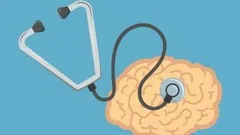
Neuroscience of Human Movement 
This course provides an in-depth exploration of the neural system responsible for movement generation, movement control and learning of actions. Students will gain an understanding of the brain processes that control movement, from the basics of neuroscience to more advanced theories. ▼
ADVERTISEMENT
Course Feature
![]() Cost:
Cost:
Free
![]() Provider:
Provider:
Youtube
![]() Certificate:
Certificate:
Paid Certification
![]() Language:
Language:
English
![]() Start Date:
Start Date:
On-Demand
Course Overview
❗The content presented here is sourced directly from Youtube platform. For comprehensive course details, including enrollment information, simply click on the 'Go to class' link on our website.
Updated in [March 06th, 2023]
This course, Neuroscience of Human Movement, is designed to provide students with an understanding of the neural system responsible for movement generation, movement control and learning of actions. It will start from the basics of neuroscience and build theory to understand the movement control system in detail and depth. The successful student of this course will be able to appreciate in-depth, the brain processes that control movement.
This course is intended for students with an interest in Neuroscience and requires only motivation and open-mindedness as prerequisites. It will prepare individuals with no knowledge of neuroscience to become knowledgeable about the neuroscience of movements.
[Applications]
The successful student of this course will be able to apply their knowledge to a variety of fields, such as physical therapy, sports science, and robotics. They will be able to understand the neural basis of movement and how to use this knowledge to improve movement performance. Additionally, they will be able to use their knowledge to develop new strategies for teaching and learning motor skills. Finally, they will be able to use their knowledge to develop new technologies for movement control and rehabilitation.
[Career Paths]
1. Neurophysiologist: Neurophysiologists are medical professionals who specialize in the study of the nervous system. They use a variety of techniques to study the structure and function of the nervous system, including EEGs, MRI scans, and other imaging techniques. Neurophysiologists are often employed in research settings, but they can also work in clinical settings, diagnosing and treating neurological disorders. The demand for neurophysiologists is expected to grow in the coming years due to the increasing prevalence of neurological disorders.
2. Neuropsychologist: Neuropsychologists specialize in the study of the relationship between the brain and behavior. They use a variety of techniques to assess and diagnose neurological disorders, and they often work in clinical settings. Neuropsychologists are in high demand due to the increasing prevalence of neurological disorders, and the demand is expected to continue to grow in the coming years.
3. Movement Scientist: Movement scientists specialize in the study of human movement. They use a variety of techniques to study the biomechanics of movement, including kinematics, kinetics, and electromyography. Movement scientists are often employed in research settings, but they can also work in clinical settings, helping to diagnose and treat movement disorders. The demand for movement scientists is expected to grow in the coming years due to the increasing prevalence of movement disorders.
4. Robotics Engineer: Robotics engineers specialize in the design and development of robots and robotic systems. They use a variety of techniques to design and build robots, including computer-aided design, 3D printing, and artificial intelligence. Robotics engineers are in high demand due to the increasing prevalence of robotics in industry and research, and the demand is expected to continue to grow in the coming years.
[Education Paths]
1. Bachelor of Science in Neuroscience: A Bachelor of Science in Neuroscience is a four-year degree program that provides students with a comprehensive understanding of the brain and nervous system. Students will learn about the anatomy and physiology of the brain, as well as the development and function of the nervous system. This degree program also covers topics such as cognitive neuroscience, neuropsychology, and neuroimaging. With the increasing demand for professionals in the field of neuroscience, this degree path is becoming increasingly popular.
2. Master of Science in Neuroscience: A Master of Science in Neuroscience is a two-year degree program that provides students with a more in-depth understanding of the brain and nervous system. Students will learn about the anatomy and physiology of the brain, as well as the development and function of the nervous system. This degree program also covers topics such as cognitive neuroscience, neuropsychology, and neuroimaging. This degree path is becoming increasingly popular as the demand for professionals in the field of neuroscience continues to grow.
3. Doctor of Philosophy in Neuroscience: A Doctor of Philosophy in Neuroscience is a four-year degree program that provides students with an advanced understanding of the brain and nervous system. Students will learn about the anatomy and physiology of the brain, as well as the development and function of the nervous system. This degree program also covers topics such as cognitive neuroscience, neuropsychology, and neuroimaging. This degree path is becoming increasingly popular as the demand for professionals in the field of neuroscience continues to grow.
4. Master of Science in Human Movement Science: A Master of Science in Human Movement Science is a two-year degree program that provides students with an in-depth understanding of the science of human movement. Students will learn about the anatomy and physiology of the body, as well as the development and function of the musculoskeletal system. This degree program also covers topics such as biomechanics, motor control, and motor learning. This degree path is becoming increasingly popular as the demand for professionals in the field of human movement science continues to grow.
Course Provider

Provider Youtube's Stats at AZClass
Neuroscience of Human Movement is an online course that focuses on the nervous systems responsible for movement generation, motor control, and motor learning. Learners will start with the basics of neuroscience and work their way up to a deeper understanding of the brain processes that control movement. Learners will also learn about industry support in the field and how it can help those without neuroscience knowledge understand the neuroscience of exercise. Additionally, learners will understand motivation and an open mind which are prerequisites for this course. This course provides students with an interest in neuroscience with the knowledge and skills to understand the neuroscience of human movement.
Discussion and Reviews
0.0 (Based on 0 reviews)
Explore Similar Online Courses

Acorn + Clearpath CNC Control Box Bench Test and Overview

Indiana Core Assessments Early Childhood Education: Test Prep & Study Guide

Python for Informatics: Exploring Information

Social Network Analysis

Introduction to Systematic Review and Meta-Analysis

The Analytics Edge

DCO042 - Python For Informatics

Causal Diagrams: Draw Your Assumptions Before Your Conclusions

Whole genome sequencing of bacterial genomes - tools and applications

Control Your Subconscious Mind: Neuroscience Hidden Secrets

Perform an Excellent Neurological Bedside Exam

Brain and Behavioral Science Fundamentals
 Related Categories
Related Categories
 Popular Providers
Popular Providers
Quiz
 Submitted Sucessfully
Submitted Sucessfully
1. What is the intended audience for the course Neuroscience of Human Movement?
2. What is the pre-requisite for the course Neuroscience of Human Movement?
3. What will the successful student of the course Neuroscience of Human Movement be able to do?
4. What is the only pre-requisite for this course?


Start your review of Neuroscience of Human Movement